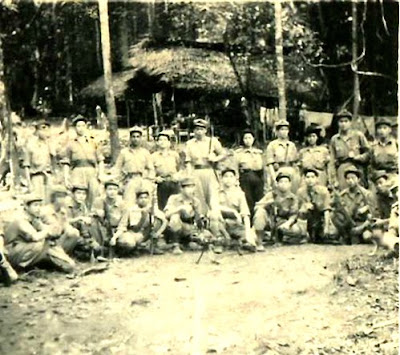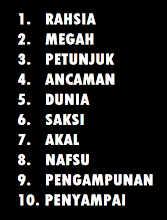Malaysian History - The Doomed Quest
By Hakim JoeThe MCP’s quest to turn Malaya into a communist nation after the Japanese surrendered in 1945 was doomed from the very beginning for within its ranks lies an ultimate turncoat who effectively used his position to advance his own agenda.
Lai Teck aka Huang Shao Dong aka Hoang A Nhac was the child of a Vietnamese father and a Chinese mother growing up in French controlled Indochina during the turn of the last century. From the very foundation of his career, Lai Teck has shown a tendency electing to side with the enemy against his own people. This trait was exhibited early as a young man when he served the French colonial government as a spy but turned out to be a brief stint as he was soon discovered by his own people early on and had to flee Indochina in a hurry.
Lai Teck was then recruited by the British security services with the intent to infiltrate the MCP. He was brought to Singapore for special training before being sent back to Malaya with forged papers (presumably from Third Communist International) in 1934 and within 5 short years, he rapidly rose through the MCP’s complicated hierarchy to become the Party’s Secretary General in April 1939. This was achieved with the help of the Malayan British security forces as all potential rivals within the party ranks were either arrested or
eliminated, paving a clear route straight to the top of the MCP command chain.
When the Japanese invasion army landed in Kota Bharu on 8 December 1941, Lai Teck has already cemented his position as the undisputed numero uno in the MCP. Those who objected his views and actions soon found themselves in British jails or “Missing In Action”. Anyone who suspected something was amiss faced similar fates and soon after, all opposition were either incarcerated or obliterated.
Lai Teck was also the Commander in Chief of the MPAJA (Malayan Peoples’ Anti-Japanese Army), the military wing of the MCP, which was formed when the British agreed to cooperate with the MCP against the Japanese a week after the Imperial Forces landed in Kota Bharu. This was only possible with Lai Teck being an agent for the British.

It must also be especially noted that not all members of the MPAJA were members of the MCP as a large majority of these fighters who survived the Onishi Kempeitei left the MPAJA to rejoin the Malayan community after the war. However the vast majority of MPAJA personnel were Malayan Chinese.
With the Japanese Army rapidly advancing south towards the British colonial HQ in Singapore, all MCP detainees were released from British prisons and a few chosen cadre were sent down to Singapore to undergo a crash course in guerilla warfare at the Special Operations Executive (SOE) 101 Special Training School in Singapore and re-disbursed back into the Malayan countryside to recruit and develop an effective underground resistance force against the Japanese invasion force.
The small initial force of only 165 MPAJA personnel that received minimal guerilla warfare training were owing to the fact that Japanese were swiftly taking over Malaya and even the last batch of trainees (Johor MCP platoon) did not manage to leave Singapore when it fell on 15 February 1942. They remained and joined the Dalforce (the largest group of volunteers) participating in the defense of Singapore, fighting alongside the British armed forces.
These MPAJA personnel formed the core the Dalley’s Desperadoes (Dalforce was commanded by Lieutenant Colonel John Dalley) and were noted for their ferocity when fighting the Japanese Army. When the Japanese invaded Malaya in 1941, Dalforce numbered approximately 4,000 resistance fighters. Initially planned to be equipped with modern armaments, most of these personnel were only issued with a Lee Enfield rifle, a bayonet together with between 7 to 20 bullets each after the liner SS Empress of Asia, carrying vital war supplies for Dalforce were sunk by Japanese aircrafts on its way from Bombay to Singapore on 4 February 1942 just 8km from Singapore.
The MPAJA personnel that were able to escape Singapore for Malaya before February 1942 were directly under the command of Lai Teck and proved ineffective against the Japanese war machine. Lai Teck was himself arrested by the Japanese in Singapore after the Sook Ching screening (18 February to 4 March 1942) where between 50,000 to 100,000 Chinese men between the ages of 18 and 50 were systematically executed at various sites including Changi Beach Park, Punggol Beach and Berhala Reping at Sentosa Beach.
However, Lai Teck was one of the few “lucky” ones and was released by the Onishi Kempeitei two weeks later in late March 1942. (Onishi Satoru, the interrogating officer who questioned Lai Teck could not confirm exactly when Lai Teck was arrested but thought the date could be the 8 March 1942). He soon left Singapore to rejoin the MCP and MPAJA in Malaya after his travel passes were approved by the Japanese Army.
The first thing Onishi Satoru obtained from Lai Teck during this two-week incarceration was the confirmation of the MCP hierarchy chart as prepared by the Japanese invasion force. This was extremely vital to the Japanese as the MPAJA was the only credible resistance forces that opposed Japanese rule in Malaya and Singapore. From hereon, Lai Teck was turned into a double agent and exclusively managed by the Kempeitei.
In April 1942, hardly a few weeks from his release, Lai Teck betrayed Huang Cheng and his wife, Li Ming to the Kempeitei. Huang Chen was then a MCP Central Committee member and the MCP’s Political Bureau’s Chairman of the Central Propaganda Department. He died on 9 August in prison while his wife was sentenced to 15 years in jail.
Also in April 1942, A Nian, MCP’s liaison officer with the CCP, Ng Yeh Lu (Singapore Town Committee member) and Lim Kang Sek (leader of the Singapore Overseas Chinese Volunteer Corps) were betrayed by Lai Teck to the Kempeitei. A Nian and Ng Yeh Lu were both sentenced to ten years imprisonment while Lim Kang Sek managed to escape on the day of his arrest. Further information provided by Lai Teck led to the recapture of Lim Kang Sek together with Lin Ya Dang (Singapore Town Committee member) and Ya Qiu (MCP Executive Committee member) in mid April 1942.
A Nian was subsequently released from prison on 1 April 1943 but re-arrested in 1944 on recommendation by Lai Teck after he witnessed a clandestine meeting between Lai Teck and his Kempeitei liaison officer, Sargeant Shimomura Yuhei. A Nian was executed in April 1944 in Johor Bharu. Lin Ya Dang committed suicide in prison on 31 July 1942 by cutting his wrist with broken glass without revealing any details to the Kempeitei during intense interrogation. Ya Qiu died the following day. Lim Kang Sek died in prison on 18 July 1942.
A Nian’s elder brother, Lin Yi-ping was arrested in July 1942 and executed by hanging on 13 May 1943. His younger brother A Chuan was also apprehended in July 1942 and died in prison in July 1944. Both were betrayed by Lai Teck to the Kempeitei.
Information and whereabouts of many other MCP and MPAJA personnel were divulged by Lai Teck to the Onishi Kempeitei including Xiao Hei (Executive Committee member) who was shot to death in April 1942, Huang Shi Rui (Chairman of the Propganda Department of MCP’s Selangor Local Committee) who was arrested on April 1942 and died in prison on 19 July 1942, Xue Feng (Central Committee member) who was arrested on April 1942 but soon died during Japanese interrogation, Lao Zhang (Singapore Town Committee member) who was arrested on April 1942 and executed in November 1942, Xiao Luo (MCP member) who was arrested on April 1942 and executed on 1 August 1942, Ya Wen (MCP Central Military Committee member) who was arrested on May 1942 and executed by hanging in 1944 in Taiping jail and Ke Min (Central Committee member) who was arrested on 10 April 1943 and duly executed.
However these piecemeal betrayals pale in comparison when Lai Teck tipped off the Kempeitei of MCP’s executive committee meeting (Conference of Party cadre and military personnel) at a rubber plantation near Batu Caves on 1 September 1942 whereby nearly the entire MCP and MPAJA top hierarchy were either killed in the Japanese ambush or captured.
Only two Executive Committee members survived the massacre – Lai Teck (he did not attend the meeting citing that his car broke down on the way there) and Xiao Ping (who escaped the ambush barely alive).
Those killed in this ambush include Zhu Lao @ Chu Ler Kwong (MPAJA 4th Independent Regiment Party representative and MCP Central Committee member), Xu Qing Biao @ See Ching Piaw (MPAJA 1st Independent Regiment Party representative), Chen Shu @ Chen Soo (MPAJA 3rd Independent Regiment
Party representative), Yee Hong @ E Fu (MPAJA 4th Independent Regiment Party representative), Zhang Qi Sheng @ Cheong Kee Sang (MPAJA 4th Independent Regiment Party representative), Zhong Zhen Kang @ Choong Chen Kang (MCP special representative), Chen Bing Hong @ Chen Fan Siong (Kedah MCP Secretary), Chen Wen Yan (Penang MCP Secretary), Ah Yen (MCP Security Chief), Lee Cheen Choong @ Siow Choong, Wang Kwong, Pao Loon, Siow Lin, Liew Yiew, Pang Yu (all MCP resistance fighters), Liew San Nai, Liew Koon
and Chang Kwan Foong (all MCP Servicing Section).
Despite this setback, the MPAJA reconstructed its organization and here is when Ong Boon Hwa @ Chin Peng rose up the Party hierarchy while Lai Teck remained the Party Chief and continued betraying those who opposed him to the Japanese.
When the Japanese surrendered in August 1945, a few hundred Japanese soldiers and civilians, for reasons unknown, decided to enlist with the MCP-MPAJA. This became a perilous situation for Lai Teck as some of these Japanese were privy to his covert collaboration with the Onishi Kempeitei. Faint rumors regarding Lai Teck as a Japanese collaborator began to surface in 1946 and by 6 March 1947, a special party meeting at
Ampang Road was officially convened to address this issue. Lai Teck was ordered to attend this hearing but he had already absconded with most of the MCP funds and a special committee was later set up to investigate Lai Teck.
During this time, the Vietnamese communists came down to Kuala Lumpur from Bangkok looking for Lai Teck but he was already gone. During their discussion with Chin Peng, the Vietnamese communists revealed that they have suspected Lai Teck to be a Japanese collaborator from information obtained from the Vietnamese community in Singapore during the war.
It was evinced that Lai Teck was frequently seen in the company of Japanese officers in Singapore and that he had two Vietnamese wives there as well. An official report was then prepared by the Vietnamese communist and submitted to Chin Peng and thereafter all evidence were compiled and resubmitted to the MCP Central Plenum in May 1947.
With these evidences, Lai Teck was finally expelled from the party. Chin Peng was then elected to be the Secretary General of the MCP, replacing Lai Teck.
Lai Teck was strangled to death by the Thai communist in Bangkok and his body tossed into the Chao Phraya River late in 1947.
When the British declared the MCP to be an illegal organization in June 1948 and with the onset of the State of Emergency in Malaya, the quest to turn Malaya into a communist nation became a doomed quest.
Sumber: http://malaysiansmustknowthetruth.blogspot.com










0 comments:
Post a Comment